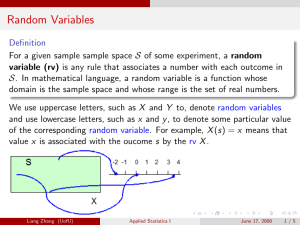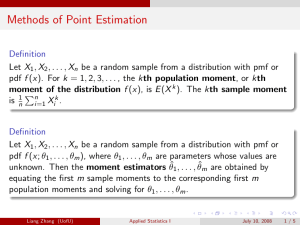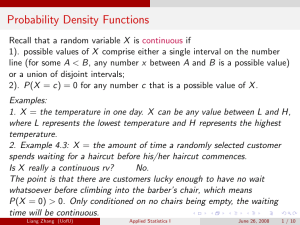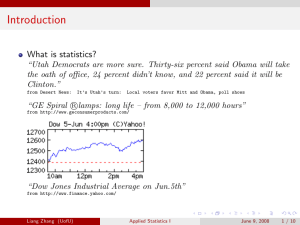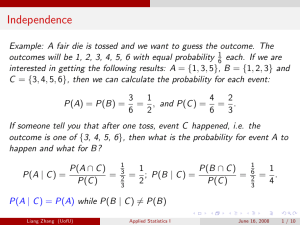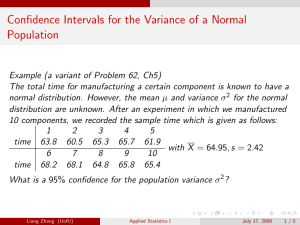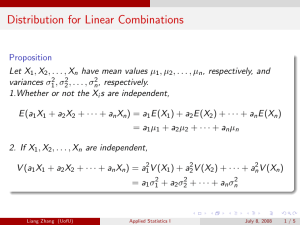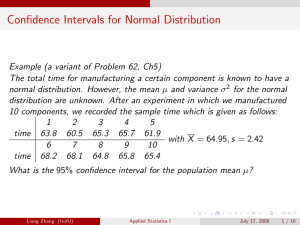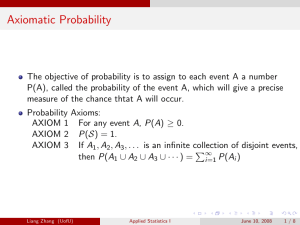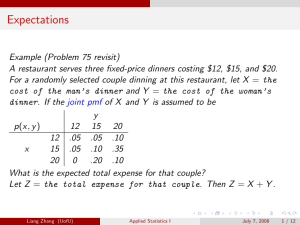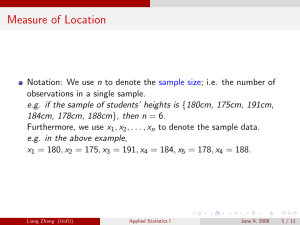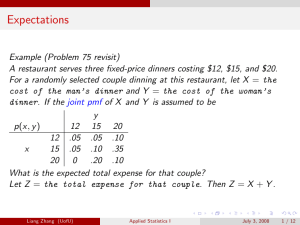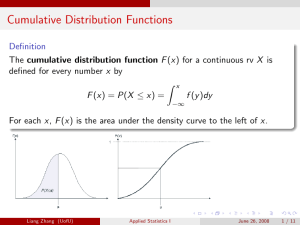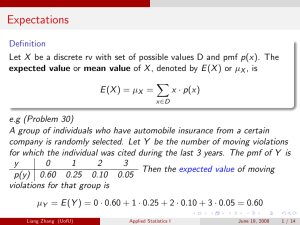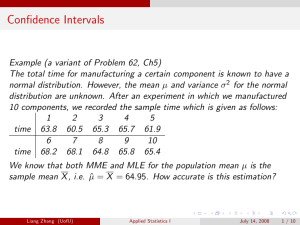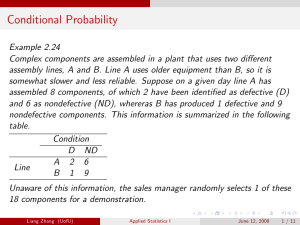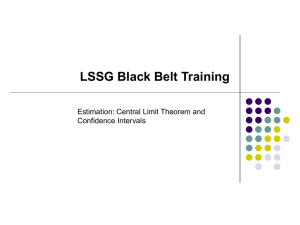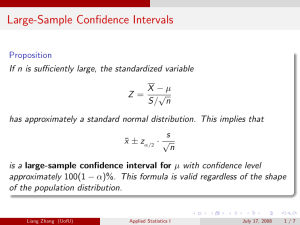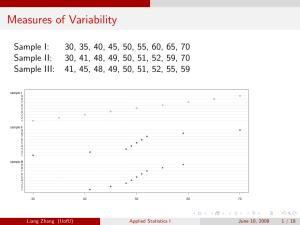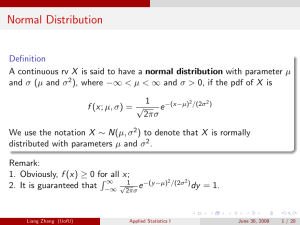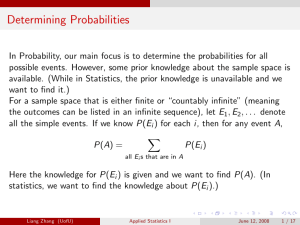Distribution for Sample Mean
advertisement
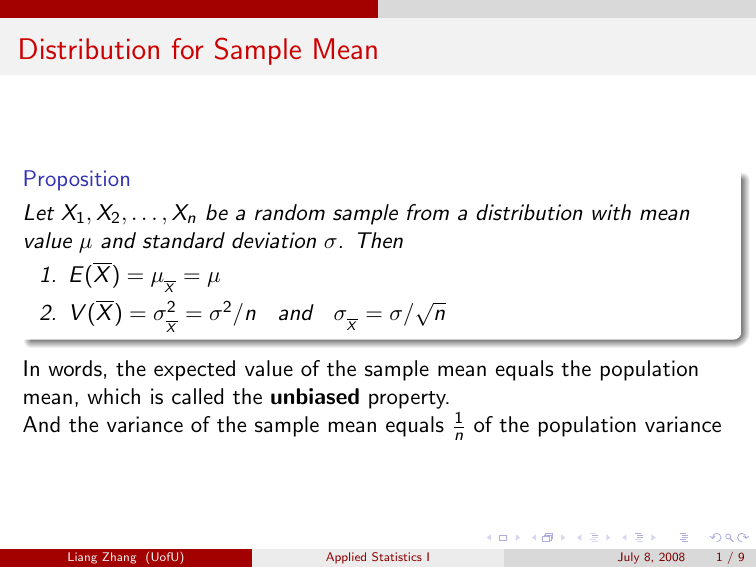
Distribution for Sample Mean Proposition Let X1 , X2 , . . . , Xn be a random sample from a distribution with mean value µ and standard deviation σ. Then 1. E (X ) = µX = µ √ 2. V (X ) = σ 2 = σ 2 /n and σX = σ/ n X In words, the expected value of the sample mean equals the population mean, which is called the unbiased property. And the variance of the sample mean equals n1 of the population variance Liang Zhang (UofU) Applied Statistics I July 8, 2008 1/9 Distribution for Sample Mean Example (Problem 38 revisit) There are two traffic lights on my way to work. Let X1 be the number of lights at which I must stop, and suppose that the distribution of X1 is as follows: x1 0 1 2 µ = 1.1, σ = .49 p(x1 ) .2 .5 .3 Let X2 be the number of lights at which I must stop on the way home; X2 is independent of X1 . Assume that X2 has the same distribution as X1 , so that X1 , X2 is a random sample of size n = 2. Let X = (X1 + X2 )/2 denote the average stops. a. Calculate µX . b. Calculate σ 2 . X Liang Zhang (UofU) Applied Statistics I July 8, 2008 2/9 Distribution for Sample Mean Proposition Let X1 , X2 , . . . , Xn be a random sample from a distribution with mean value µ and standard deviation σ. Define T0 = X1 + X2 + · · · + Xn , then √ E (T0 ) = nµ, V (T0 ) = nσ 2 and σT0 = nσ Liang Zhang (UofU) Applied Statistics I July 8, 2008 3/9 Distribution for Sample Mean Proposition Let X1 , X2 , . . . , Xn be a random sample from a normal distribution with mean value µ and standard deviation σ. Then for any n, X is normally √ distributed (with mean value µ and standard deviation σ/ n), as is T0 √ (with mean value nµ and standard deviation nσ). Liang Zhang (UofU) Applied Statistics I July 8, 2008 4/9 Distribution for Sample Mean Example (Problem 54) Suppose the sediment density (g/cm) of a randomly selected specimen from a certain region is normally distributed with mean 2.65 and standard deviation .85 (suggested in “Modeling Sediment and Water Column Interactions for Hydrophobic Pollutants”, Water Research, 1984: 1169-1174). a. If a random sample of 25 specimens is selected, what is the probability that the sample average sediment density is at most 3.00? b. How large a sample size would be required to ensure that the above probability is at least .99? Liang Zhang (UofU) Applied Statistics I July 8, 2008 5/9 Distribution for Sample Mean The Central Limit Theorem (CLT) Let X1 , X2 , . . . , Xn be a random sample from a distribution with mean value µ and standard deviation σ. Then if n is sufficiently large, X has approximately a normal distribution with mean value µ and standard √ deviation σ/ n, and T0 also has approximately a normal distribution with √ mean value nµ and standard deviation nσ. The larger the value of n, the better the approximation. Remark: 1. As long as n is sufficiently large, CLT is applicable no matter Xi ’s are discrete random variables or continuous random variables. 2. How large should n be such that CLT is applicable? Generally, if n > 30, CLT can be used. Liang Zhang (UofU) Applied Statistics I July 8, 2008 6/9 Distribution for Sample Mean Example (Problem 49) There are 40 students in an elementary statistics class. On the basis of years of experience, the instructor knows that the time needed to grade a randomly chosen first examination paper is a random variable with an expected value of 6 min and a standard deviation of 6 min. a. If grading times are independent and the instructor begins grading at 6:50pm and grades continuously, what is the (approximate) probability that he is through grading before the 11:00pm TV news begins? b. If the sports report begins at 11:10pm, what is the probability that he misses part of the report if he waits unitl grading is done before turning on the TV? Liang Zhang (UofU) Applied Statistics I July 8, 2008 7/9 Distribution for Sample Mean The original version of CLT The Central Limit Theorem (CLT) Let X1 , X2 , . . . be a sequence of i.i.d. random variables from a distribution with mean value µ and standard deviation σ. Define random variables Pn Xi − nµ Yn = i=1√ for n = 1, 2, . . . nσ Then as n → ∞, Yn has approximately a normal distribution. Liang Zhang (UofU) Applied Statistics I July 8, 2008 8/9 Distribution for Sample Mean Corollary Let X1 , X2 , . . . , Xn be a random sample from a distribution for which only positive values are possible [P(Xi > 0) = 1]. Then if n is sufficiently large, the product Y = X1 X2 · · · Xn has approximately a lognormal distribution. Liang Zhang (UofU) Applied Statistics I July 8, 2008 9/9
